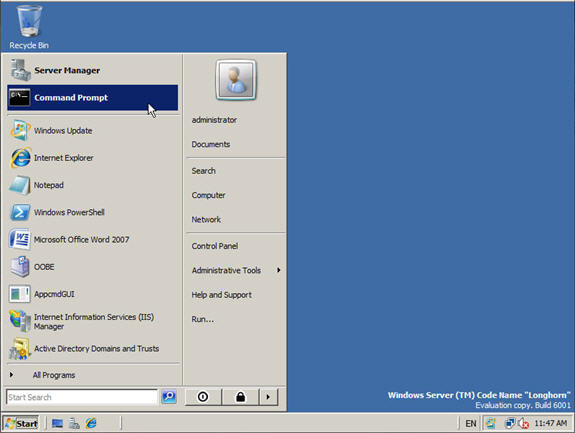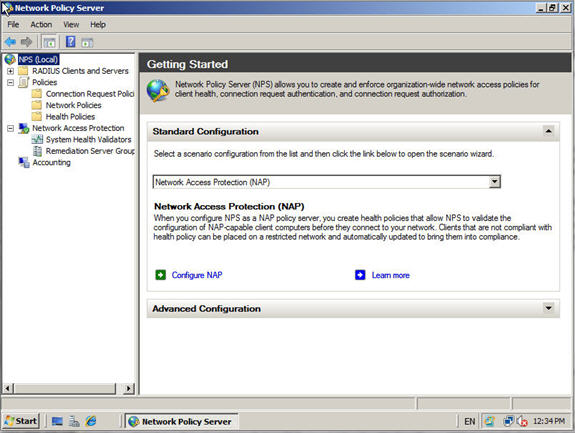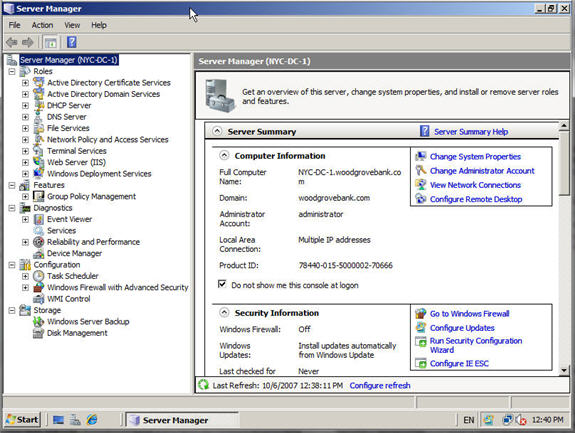Today I downloaded the recently released Windows Server 2008 release candidate 0 (RC0) evaluation. This is about a 4GB free evaluation. I installed it inside VMware and wanted to offer my review of the latest Windows Server OS, its features, and benefits.
Microsoft says that Windows Server 2008 is the “most advanced and secure server operating system” that they have ever released. While that is a tall order to stand up to, I do believe that Windows Server 2008 has many new features included that system administrators of small and large companies will enjoy.
Let’s start off with the new look and feel of Windows Server 2008…
The new look & feel of Windows Server 2008
The first thing that new Server 2008 users will notice is the new look and feel of Windows Server 2008. If fact, if you have used Windows Vista, you will notice how similar it is to Windows Server 2008.
This new look and feel is something that will take some getting used to. As Windows system admins, we are used to going to the same place, over and over, to accomplish the same task. Because of this, initially, you may feel a little lost in Windows Server 2008.
For example, one of the first things I noticed is that the Run command was missing from the Start Menu. Now you just have to click on the Start Search area of the Start Menu and type in the command that you need. (Figure 1)

Figure 1: The new look and feel of Windows Server 2008
They have also removed the add/remove programs icon in control panel. These are just some of things that you will need get used to when using Windows Server 2008.
Is it better or worse? In my opinion, it is “just different”.
Enhanced Security Features of Windows Server 2008
As Microsoft says that Windows Server 2008 is the “most secure” server OS they have every created, I want to take a minute to touch on the security features of Server 2008. Here is my list:
- Active Directory Federation Service – allows administrators to easily set up trust relationships with federation partners.
- Read-Only Domain Controllers – these domain controllers will be used in environments where you need a domain controller but you cannot guarantee the physical security of the server.
- Server Core Installation – a new type of install of Windows Server 2008 that will allow you to only install the typical Windows network infrastructure services – DHCP, DNS, file sharing, and domain controller functions. What is a big change for most admins is that if you choose to use the “server core” installation, there will be no local GUI interface to the OS.
- Password and account lockout policy improvements – offers the ability to have multiple password and account policies in a single domain.
- Windows BitLocker Drive Encryption – allows you to encrypt all of the hard drives on a server. This will prevent the data from being viewed if a hard drive or the server is stolen.
You can view more Windows Server 2008 features and benefits at the Server 2008 Product Overview.
The New & Improved Server 2008 Web Server – IIS 7.0
We have to keep in mind that there are so many other applications included in the Windows Server 2008 OS. One of those is Internet Information Server. With Windows Server 2008, IIS has been upgraded to version 7.0. With this upgrade, IIS 7.0 is easier to manage due to its improved interface. The interface offers the ability to perform common tasks faster, security enhancements, web server health information, delegation of administration, and more. With IIS 7.0, your access to diagnostic and troubleshooting information is much easier and quicker (Figure 2).

Figure 2: The new IIS 7.0 Management Interface
Speed Client Operating System Deployment with WDS
Windows Deployment Service (WDS) is a new Server 2008 feature that allows you to deploy Windows client machines over the network. The new WDS is faster because it uses TFTP. WDS offers client installs performed with either ScheduleCast or AutoCast.
ScheduleCast is a scheduled deployment whereas AutoCast is an “always available” deployment using Multicast. Because AutoCast uses Multicast, you can save on bandwidth by all clients sharing the same streaming data over the network.
Secure your network from unsafe PC clients with Network Access Protection
Microsoft’s Network Access Protection (NAP) is a new policy that can be put into place, requiring clients to meet certain requirements before they can connect to a Windows 2008 server.
If they do not meet the requirements that are set, the client can be quarantined or can be denied access. Even better, if the computer does not meet the requirements, the Windows 2008 Server can deploy the necessary updates that are needed.
By using NAP, you can secure not only local PCs but also home computers or roaming computers that attempt to connect to your network from your LAN or via the Internet with a VPN.

Figure 3: Network Policy Server Interface
Windows Terminal Services Improvements
Windows Terminal Services has been greatly improved in Windows Server 2008. Here are some of the new key features:
- RemoteApp – similar to published applications in Citrix, RemoteApp will allow you to share an application with a workstation instead of the entire Windows desktop. It is supposed to have seamless integration with the client PCs so that clients will just see an icon in their start menu or desktop and click on it to run the application.
- Terminal Services Gateway – allows remote users who are working away from the office to connect to terminal services. This will help remove the need for remote VPN access for some users.
- Terminal Services Web Access – offers the ability for remote users to connect to terminal services with just a web browser. By using this, remote PCs attempting to connect to terminal services do not need to have the remote desktop client or VPN.
All three of these features are very similar to existing Citrix Metaframe features.
One Stop Server Management with Server Manager
Windows Server 2008 Server Manager is a new console that will put all the snap-ins you need to manage your server in a single place, making it easier and faster to for administrators to manage Windows 2008 Servers.

Figure 4: Server Manager Console
New Windows Server Virtualization Features
Windows Server Virtualization is a new feature that allows you to virtualize any operating system onto one server. This feature will also allow you consolidate many servers into one server. This will allow you to easily create test and development environments without having to use too many resources.
With this feature, Microsoft is hoping to take away a great deal of the virtualization marketplace from VMware. While Microsoft certainly lags far behind VMware in the maturing of their virtualization offerings, by Microsoft offering virtualization already built into the Windows OS, they are going a long way to getting their version of virtualization in the hands of the end user.
As we are just now getting a look at Microsoft’s version of Hypervisor virtualization in the recently released Windows Server 2008 RC0, it is too soon to say how good of a virtualization feature set Microsoft will offer. I encourage you to take a look at it for yourself.
Conclusion
Windows Server 2008 has received a facelift and changed the way it looks and feels. There will be some people who like the fresh look of Windows Server 2008 and there will be people who don’t care for it. Either way, the long list of features will go a long way to encourage system administrators to trying out the new Server OS. Additionally, there are many new key security features that have made the server more secure. But will these features really make it more secure or just make the server harder to use? Will Windows 2008 be the most secure and advanced server that Microsoft has ever released? Only thorough testing by IT system administrators will show just how good Windows Server 2008 will be.
For more information visit:
Microsoft: Windows Server 2008 Homepage
Microsoft: Windows Server 2008 Highlighted Features



